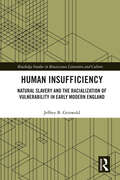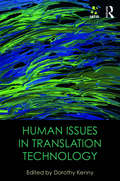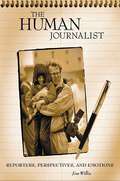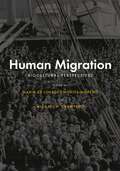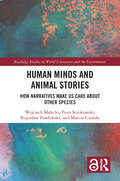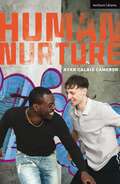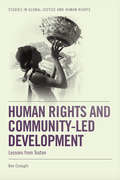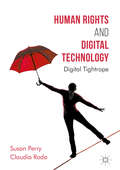- Table View
- List View
Human Evolution and Fantastic Victorian Fiction (Routledge Studies in Speculative Fiction)
by Anna NeillFollowing the publication of Darwin’s On the Origin of Species, Victorian anthropology made two apparently contradictory claims: it distinguished "civilized man" from animals and "primitive" humans and it linked them though descent. Paradoxically, it was by placing human history in a deep past shaped by minute, incremental changes (rather than at the apex of Providential order) that evolutionary anthropology could assert a new form of human exceptionalism and define civilized humanity against both human and nonhuman savagery. This book shows how fantastic Victorian and early Edwardian fictions—utopias, dystopias, nonsense literature, gothic horror, and children’s fables—untether human and nonhuman animal agency from this increasingly orthodox account of the deep past. As they imagine worlds that lift the evolutionary constraints on development and as they collapse evolution into lived time, these stories reveal (and even occupy) dynamic landscapes of cognitive descent that contest prevailing anthropological ideas about race, culture, and species difference.
The Human Factor in Machine Translation (Routledge Studies in Translation Technology)
by Sin-Wai ChanMachine translation has become increasingly popular, especially with the introduction of neural machine translation in major online translation systems. However, despite the rapid advances in machine translation, the role of a human translator remains crucial. As illustrated by the chapters in this book, man-machine interaction is essential in machine translation, localisation, terminology management, and crowdsourcing translation. In fact, the importance of a human translator before, during, and after machine processing, cannot be overemphasised as human intervention is the best way to ensure the translation quality of machine translation. This volume explores the role of a human translator in machine translation from various perspectives, affording a comprehensive look at this topical research area. This book is essential reading for anyone involved in translation studies, machine translation or interested in translation technology.
The Human Factor in Machine Translation (Routledge Studies in Translation Technology)
by Sin-Wai ChanMachine translation has become increasingly popular, especially with the introduction of neural machine translation in major online translation systems. However, despite the rapid advances in machine translation, the role of a human translator remains crucial. As illustrated by the chapters in this book, man-machine interaction is essential in machine translation, localisation, terminology management, and crowdsourcing translation. In fact, the importance of a human translator before, during, and after machine processing, cannot be overemphasised as human intervention is the best way to ensure the translation quality of machine translation. This volume explores the role of a human translator in machine translation from various perspectives, affording a comprehensive look at this topical research area. This book is essential reading for anyone involved in translation studies, machine translation or interested in translation technology.
Human Forms: The Novel in the Age of Evolution
by Ian DuncanA major rethinking of the European novel and its relationship to early evolutionary scienceThe 120 years between Henry Fielding's Tom Jones (1749) and George Eliot's Middlemarch (1871) marked both the rise of the novel and the shift from the presumption of a stable, universal human nature to one that changes over time. In Human Forms, Ian Duncan reorients our understanding of the novel's formation during its cultural ascendancy, arguing that fiction produced new knowledge in a period characterized by the interplay between literary and scientific discourses—even as the two were separating into distinct domains.Duncan focuses on several crisis points: the contentious formation of a natural history of the human species in the late Enlightenment; the emergence of new genres such as the Romantic bildungsroman; historical novels by Walter Scott and Victor Hugo that confronted the dissolution of the idea of a fixed human nature; Charles Dickens's transformist aesthetic and its challenge to Victorian realism; and George Eliot's reckoning with the nineteenth-century revolutions in the human and natural sciences. Modeling the modern scientific conception of a developmental human nature, the novel became a major experimental instrument for managing the new set of divisions—between nature and history, individual and species, human and biological life—that replaced the ancient schism between animal body and immortal soul.The first book to explore the interaction of European fiction with "the natural history of man" from the late Enlightenment through the mid-Victorian era, Human Forms sets a new standard for work on natural history and the novel.
Human Insufficiency: Natural Slavery and the Racialization of Vulnerability in Early Modern England (Routledge Studies in Renaissance Literature and Culture)
by Jeffrey B. GriswoldHuman Insufficiency argues that early modern writers depict the human political subject as physically vulnerable in order to naturalize slavery. Representations of Man as a weak creature—“poor” and “bare” in King Lear’s words—strategically portrayed English bodies as needing care from people who were imagined to be less fragile. Drawing on Aristotle’s depictions of the natural master and the natural slave in the Politics, English writers distinguished the fully human political subject from the sub-human Slave who would care for his feeble body. This justification of a nascent slaving economy reinvents the violence of enslaving Afro-diasporic peoples as a natural system of care. Human Insufficiency’s most important contribution to early modern critical race studies is expanding the scope of the human as a racialized category by demonstrating how depictions of Man as a vulnerable species were part of a discourse racializing slavery.
Human Insufficiency: Natural Slavery and the Racialization of Vulnerability in Early Modern England (Routledge Studies in Renaissance Literature and Culture)
by Jeffrey B. GriswoldHuman Insufficiency argues that early modern writers depict the human political subject as physically vulnerable in order to naturalize slavery. Representations of Man as a weak creature—“poor” and “bare” in King Lear’s words—strategically portrayed English bodies as needing care from people who were imagined to be less fragile. Drawing on Aristotle’s depictions of the natural master and the natural slave in the Politics, English writers distinguished the fully human political subject from the sub-human Slave who would care for his feeble body. This justification of a nascent slaving economy reinvents the violence of enslaving Afro-diasporic peoples as a natural system of care. Human Insufficiency’s most important contribution to early modern critical race studies is expanding the scope of the human as a racialized category by demonstrating how depictions of Man as a vulnerable species were part of a discourse racializing slavery.
Human Issues in Translation Technology: The IATIS Yearbook (The IATIS Yearbook)
by Dorothy KennyTranslation technologies are moulded by and impact upon humans in all sorts of ways. This state-of-the-art volume looks at translation technologies from the point of view of the human users – as trainee, professional or volunteer translators, or as end users of translations produced by machines. Covering technologies from machine translation to online collaborative platforms, and practices from ‘traditional’ translation to crowdsourced translation and subtitling, this volume takes a critical stance, questioning both utopian and dystopian visions of translation technology. In eight chapters, the authors propose ideas on how technologies can better serve translators and end users of translations. The first four chapters explore how translators – in various contexts and with widely differing profiles – use and feel about translation technologies as they currently stand, while the second four chapters focus on the future: on anticipating needs, identifying emerging possibilities, and defining interventions that can help to shape translation practice and research. Drawing on a range of theories from cognitive to social and psychological, and with empirical evidence of what the technologization of the workplace means to translators, Human Issues in Translation Technology is key reading for all those involved in translation and technology, translation theory and translation research methods.
Human Issues in Translation Technology: The IATIS Yearbook (The IATIS Yearbook)
by Dorothy KennyTranslation technologies are moulded by and impact upon humans in all sorts of ways. This state-of-the-art volume looks at translation technologies from the point of view of the human users – as trainee, professional or volunteer translators, or as end users of translations produced by machines. Covering technologies from machine translation to online collaborative platforms, and practices from ‘traditional’ translation to crowdsourced translation and subtitling, this volume takes a critical stance, questioning both utopian and dystopian visions of translation technology. In eight chapters, the authors propose ideas on how technologies can better serve translators and end users of translations. The first four chapters explore how translators – in various contexts and with widely differing profiles – use and feel about translation technologies as they currently stand, while the second four chapters focus on the future: on anticipating needs, identifying emerging possibilities, and defining interventions that can help to shape translation practice and research. Drawing on a range of theories from cognitive to social and psychological, and with empirical evidence of what the technologization of the workplace means to translators, Human Issues in Translation Technology is key reading for all those involved in translation and technology, translation theory and translation research methods.
The Human Journalist: Reporters, Perspectives, and Emotions (Non-ser.)
by Jim WillisWillis examines the many orientations and perspectives of reporters that gather and present the news of the day. Debunking the notion that there are limited perspectives journalists may use, Willis examines up to 15 different orientations that reporters bring to their work. These perspectives run the gamut, from the traditional approach of distancing oneself completely from events and people involved to becoming part of the story's fabric to ascertain the story's true essence.Willis also suggests that, for many stories, it is wholly appropriate for journalists to feel what a non-professional would experience at such an event, and to allow those emotions to fuel the reporting and writing of the story. Several examples are discussed in detail, including the coverage of the bombing of the Alfred P. Murrah Federal Building in Oklahoma City on April 19, 1995, and the terrorist attacks of September 11, 2001.
Human Language Technologies for Under-Resourced African Languages: Design, Challenges, and Prospects (SpringerBriefs in Speech Technology)
by Moses Effiong EkpenyongThis book provides an overview of a recent and flexible approach to speech synthesis design to develop the first statistical parametric speech synthesizer for Ibibio, a West African tonal language. The design precludes the inflexibility encountered when modeling tonal features of the language and can be used for other tonal African languages. Mobile use and technological innovations in developing African nations have exploded. With mobile technology, many of the barriers caused by infrastructure issues have vanished. In order to address issues that are unique to African tonal languages, the book uses Ibibio as a model. The text reviews the language's speech characteristics, required for building the front end components of the design and propose a finite state transducer (FST), useful for modelling the language’s tonetactics. The statistical parametric approach discussed in the text, implements the Hidden Markov Model (HMM) technique, with the goal of creating a generic structure that learns the model from the text itself, and uses the data-driven approach to input specification.
Human Migration: Biocultural Perspectives
by Maria De Lourdes Muñoz-Moreno and Michael H. CrawfordStudying human migratory patterns can help us make sense of evolution, biology, linguistics, and so much more. Human Migration takes readers through population development and their respective origins to create a comprehensive picture of human migratory patterns. This book explores human migration as a major contributor to globalization that facilitates gene flow and the exchange of cultures and languages. It also traces evolutionary success of a hybrid population, the Black Caribs, after their forced relocation from St. Vincent Island to the Bay Islands and Central America. The volume is split into four sections: Theoretical Overview; Ancient DNA and Migration; Regional Migration; Culture and Migration: and Disease and Migration. This division allows for a seamless transition between a broad range of topics, including molecular genetics, linguistics, cultural anthropology, history, archaeology, demography, and genetic epidemiology. Assembled by volume editors and migration specialists María de Lourdes Muñoz-Moreno and Michael H. Crawford, Human Migration creates an opportunity for researchers, professionals, and students from different fields to review and discuss the most recent trends and challenges surrounding migration, genetics, and anthropology.
Human Migration: Biocultural Perspectives
Studying human migratory patterns can help us make sense of evolution, biology, linguistics, and so much more. Human Migration takes readers through population development and their respective origins to create a comprehensive picture of human migratory patterns. This book explores human migration as a major contributor to globalization that facilitates gene flow and the exchange of cultures and languages. It also traces evolutionary success of a hybrid population, the Black Caribs, after their forced relocation from St. Vincent Island to the Bay Islands and Central America. The volume is split into four sections: Theoretical Overview; Ancient DNA and Migration; Regional Migration; Culture and Migration: and Disease and Migration. This division allows for a seamless transition between a broad range of topics, including molecular genetics, linguistics, cultural anthropology, history, archaeology, demography, and genetic epidemiology. Assembled by volume editors and migration specialists María de Lourdes Muñoz-Moreno and Michael H. Crawford, Human Migration creates an opportunity for researchers, professionals, and students from different fields to review and discuss the most recent trends and challenges surrounding migration, genetics, and anthropology.
The Human Mind through the Lens of Language: Generative Explorations
by Nirmalangshu MukherjiMost living forms in nature display various cognitive abilities in their behaviour. However, except for humans, no other animal builds fires and wheels, navigates with maps and tells stories to other conspecifics. We can witness this unique feature of the human mind in almost everything humans do, such as painting, singing and cooking; there is an underlying sense of unity in the generative part of these systems despite wide differences in what they are about.This book introduces, defends and develops a novel philosophical approach to the study of the generative mind. Nirmalangshu Mukherji argues for a single, species-specific generative principle that accounts for the human ability to combine symbolic forms without bound in each domain that falls under the generative mind.
The Human Mind through the Lens of Language: Generative Explorations
by Nirmalangshu MukherjiMost living forms in nature display various cognitive abilities in their behaviour. However, except for humans, no other animal builds fires and wheels, navigates with maps and tells stories to other conspecifics. We can witness this unique feature of the human mind in almost everything humans do, such as painting, singing and cooking; there is an underlying sense of unity in the generative part of these systems despite wide differences in what they are about.This book introduces, defends and develops a novel philosophical approach to the study of the generative mind. Nirmalangshu Mukherji argues for a single, species-specific generative principle that accounts for the human ability to combine symbolic forms without bound in each domain that falls under the generative mind.
Human Minds and Animal Stories: How Narratives Make Us Care About Other Species (Routledge Studies in World Literatures and the Environment)
by Wojciech Małecki Piotr Sorokowski Bogusław Pawłowski Marcin CieńskiThe power of stories to raise our concern for animals has been postulated throughout history by countless scholars, activists, and writers, including such greats as Thomas Hardy and Leo Tolstoy. This is the first book to investigate that power and explain the psychological and cultural mechanisms behind it. It does so by presenting the results of an experimental project that involved thousands of participants, texts representing various genres and national literatures, and the cooperation of an internationally-acclaimed bestselling author. Combining psychological research with insights from animal studies, ecocriticism and other fields in the environmental humanities, the book not only provides evidence that animal stories can make us care for other species, but also shows that their effects are more complex and fascinating than we have ever thought. In this way, the book makes a groundbreaking contribution to the study of relations between literature and the nonhuman world as well as to the study of how literature changes our minds and society. "As witnessed by novels like Black Beauty and Uncle Tom’s Cabin, a good story can move public opinion on contentious social issues. In Human Minds and Animal Stories a team of specialists in psychology, biology, and literature tells how they discovered the power of narratives to shift our views about the treatment of other species. Beautifully written and based on dozens of experiments with thousands of subjects, this book will appeal to animal advocates, researchers, and general readers looking for a compelling real-life detective story." - Hal Herzog, author of Some We Love, Some We Hate, Some We Eat : Why It’s So Hard To Think Straight About Animals
Human Minds and Animal Stories: How Narratives Make Us Care About Other Species (Routledge Studies in World Literatures and the Environment)
by Wojciech Małecki Piotr Sorokowski Bogusław Pawłowski Marcin CieńskiThe power of stories to raise our concern for animals has been postulated throughout history by countless scholars, activists, and writers, including such greats as Thomas Hardy and Leo Tolstoy. This is the first book to investigate that power and explain the psychological and cultural mechanisms behind it. It does so by presenting the results of an experimental project that involved thousands of participants, texts representing various genres and national literatures, and the cooperation of an internationally-acclaimed bestselling author. Combining psychological research with insights from animal studies, ecocriticism and other fields in the environmental humanities, the book not only provides evidence that animal stories can make us care for other species, but also shows that their effects are more complex and fascinating than we have ever thought. In this way, the book makes a groundbreaking contribution to the study of relations between literature and the nonhuman world as well as to the study of how literature changes our minds and society. "As witnessed by novels like Black Beauty and Uncle Tom’s Cabin, a good story can move public opinion on contentious social issues. In Human Minds and Animal Stories a team of specialists in psychology, biology, and literature tells how they discovered the power of narratives to shift our views about the treatment of other species. Beautifully written and based on dozens of experiments with thousands of subjects, this book will appeal to animal advocates, researchers, and general readers looking for a compelling real-life detective story." - Hal Herzog, author of Some We Love, Some We Hate, Some We Eat : Why It’s So Hard To Think Straight About Animals
Human Nurture (Modern Plays)
by Ryan Calais CameronI don't agree with everything they say, but we do have a lot in common nowadays; anyway, I can't be racist, my best friend is Black.Roger and Harry's bond is so strong they could be brothers. They share the same food, music, computer games and even dreams... Everything other than their race. Roger is black, and Harry is white. But what does that matter, right? When Roger is re-homed, Harry is left behind in the care system, and these 'brothers' grow up in opposite ends of Britain's social spectrum. Then on Harry's birthday, Runaku (Roger's reclaimed Zimbabwean birth name) returns for a dream reunion that turns into a nightmare situation. Human Nurture is an explosive new play from Ryan Calais Cameron where nothing's off-limits: from innocent primary school humiliations to race, privilege, allyship and male vulnerability.
Human Nurture (Modern Plays)
by Ryan Calais CameronI don't agree with everything they say, but we do have a lot in common nowadays; anyway, I can't be racist, my best friend is Black.Roger and Harry's bond is so strong they could be brothers. They share the same food, music, computer games and even dreams... Everything other than their race. Roger is black, and Harry is white. But what does that matter, right? When Roger is re-homed, Harry is left behind in the care system, and these 'brothers' grow up in opposite ends of Britain's social spectrum. Then on Harry's birthday, Runaku (Roger's reclaimed Zimbabwean birth name) returns for a dream reunion that turns into a nightmare situation. Human Nurture is an explosive new play from Ryan Calais Cameron where nothing's off-limits: from innocent primary school humiliations to race, privilege, allyship and male vulnerability.
Human Resource Management: Rhetorics and Realities (Management, Work and Organisations)
by Karen LeggeThis best-selling text in the Management Work and Organisations series analyses personnel management and HRM from a critical perspective, questioning their place in the labour process and broader socio-politico-economic context. It provides a refreshing and original look at the major debates surrounding HRM and has been widely adopted as a recommended text for a variety of postgraduate HRM and Industrial relations courses.
Human Rights and Community-led Development: Lessons from Tostan (Studies In Global Justice And Human Rights Ser.)
by Ben CislaghiProvides cross-disciplinary perspectives on the study of animals in humanities
Human Rights and Community-led Development: Lessons from Tostan
by Ben CislaghiExamines the influence of classical philosophy on revenge narratives by Shakespeare and his contemporaries
Human Rights and Digital Technology: Digital Tightrope
by Claudia Roda Susan PerryAnalysing the convergence of law and regulation with rapidly evolving communications technologies, this interdisciplinary work navigates the intricate balancing act between human rights protection and technological innovation in a digital age, and illuminates the comprehensive potential of human rights to frame our intelligent use of technology. The authors address such pressing questions as how to protect user privacy online, whether digital pollution is a health hazard, who should have control and be responsible for data technologies and how to maintain human autonomy in a world of interconnected objects. By considering specific cases, this book provides an in-depth exploration of the many regulatory and technological choices citizens, states, civil society organizations and the private sector should consider to ensure that digital technology more fully serves human needs.
Human Rights and Literature: Writing Rights
by Pramod K. NayarSet at the intersection of Human Rights, social justice and Literature, this cutting edge book examines a range of literary texts, fiction, plays and poetry, and through them considers representations of Human Rights and their violations. Examining violated bodies and subjects, the settings and environments in which these are embedded and the witnessing of atrocities, it considers how the ‘subject’ (or ‘person’ of Human Rights) emerges within fiction or poetry. Structured so as to move outward from the individual body to the world, the study progresses from the preconditions or settings for Human Rights violations through to atrocity, from witnessing to the making of a specific kind of public around traumatic recall. It addresses representations of destroyed corporeality and subjectivity, the violations and dissolution of the subject and the construction of trauma-memory citizenship to the making of communities of mourning. Through a broad study of texts from different genres, this text reveals how Literature both documents the basic human aspirations of happiness, security and hope, but also the limitations and the violations of these aspirations.
Human Rights and Media (Studies in Communications #6)
by Diana PapademasVolume 6 on "Human Rights and Media" introduces and analyzes the significant relationship and discourse of human rights and media. As agenda setters, framers and integral actors in human rights movements, various forms of media are analyzed by the contributing authors. News media, the press, television, cinema, photojournalism, the internet and other documentary forms are among the media investigated by the authors. Civil society dialogue, the rhetoric and ideology of human rights, the propaganda and media responsibility around such themes as war, genocide, ethnic division, nationalism, race, gender, child labor and disability are human rights themes addressed in this volume.



